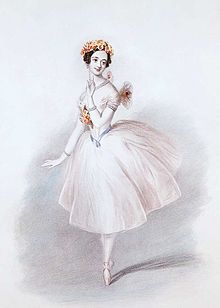La Sylphide
La Sylphide is a romantic ballet pantomime in two acts. The libretto was created by Adolphe Nourrit , the music composed by Jean-Madeleine Schneitzhoeffer , and the choreography by Filippo Taglioni .
Origin, performances, versions
The first performance took place on March 12, 1832 in the Théâtre de l'Academie Royale de Musique , the theater of the royal music academy, in Paris , the title role was danced by Marie Taglioni . Further performances with the Taglioni took place on July 26, 1832 in Covent Garden / London , on September 18, 1837 in Saint Petersburg or on May 19, 1841 at La Scala in Milan .
After the music by Herman Severin Løvenskiold , who enriched the score with original Scottish melodies, and in the new version by August Bournonville based on Filippo Taglioni's choreography , a second version was performed on November 28, 1836 at the Royal Opera in Copenhagen . In this production, Lucile Grahn danced the title role. This version is the best known to this day.
In 1972 Pierre Lacotte brought out a reconstruction of Taglioni's original choreography at the Paris Opera , which was adopted by the Hamburg State Opera in 2008 .
action
The plot of the ballet is based on the novella Trilby by the French Charles Nodier .
The scene of the action is the Scottish highlands . The shepherd James is on the eve of his wedding when a winged forest fairy ( Sylphide ) falls in love with him and shows himself to him. James also falls in love with the mythical creature, but is still willing to marry his bride Effie. The old witch Madge foretells Effie that her groom loves someone more than she does, whereupon James throws the witch out. In the subsequent dance with his bride, James is again disturbed by the fairy, but no one except him can see her. In front of the altar, James notices that the wedding rings have disappeared. At her signal, he follows the fairy into the forest. There, among her sisters, he realizes that his love as a mortal for an immortal being is hopeless. So he asks the witch to help him find the fairy. This gives him an enchanted scarf with which he can banish the mythical creature. After James the Sylphide puts on the scarf, she dies in the arms of the other fairies. When James notices that Effie is meanwhile about to marry another man, he wants to kill the witch. However, this gets ahead of him and kills him with a curse.
To the meaning
After the dance of the damned nuns in the third act of the opera Robert le diable , which indicated a turning point in the ballet, La Sylphide is considered the beginning of the Romantic Ballet, whose best-known work is still Giselle today. In addition, the interpretation of the role by the Taglioni meant the breakthrough for the point dance , which she mastered masterfully. The white fantasy costume of the Sylphide with the calf-length tulle skirt ( tutu ) has also remained one of the classic ballet costumes to this day.
Trivia
The ballet, called Les Sylphides , based on compositions by Frédéric Chopin and performed in 1902 by the Ballets Russes in the choreography of Michel Fokine , is also based on the mythical creature of Sylphide, but otherwise has nothing to do with the ballet described here.

